1. Cheng-Xia Miao, Jin-Quan Wang, Bing Yu, Wei-Guo Cheng, Jian Sun, Sébastien Chanfreau, Liang-Nian He* and Suo-Jiang Zhang*, Synthesis of bimagnetic ionic liquid and application for selective aerobic oxidation of aromatic alcohols under mild conditions, Chem. Commun., 2011, 47, 2697-2699. [link]
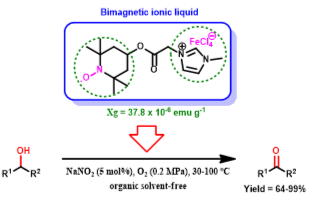
Abstract: The first bimagnetic ionic liquid based on Fe and TEMPO with cooperative functionalities not only exhibited strong paramagnetic behaviour at room temperature under an applied magnetic field of 5000 Oe but also proved to be an effective catalyst for selective aerobic oxidation of aromatic alcohols under mild and clean conditions.
2. Cheng-Xia Miao, Bing Yu and Liang-Nian He*, Tert-butyl nitrite: a metal-free radical initiator for aerobic cleavage of benzylic C=C bond in compressed carbon dioxide, Green Chem., 2011, 13 (3), 541-544.[link]
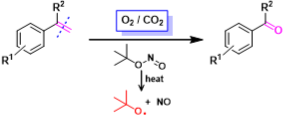
Abstract: Tert-butyl nitrite easily releasing alkoxyl radical and NO in combination with compressed CO2 under metal free condition was applied to efficiently and selectively initiate aerobic cleavage of benzylic C=C bonds. Notably, compressed CO2 in this study not only provides a safe reaction environment but also tunes the selectivity.
3. Jian Gao, Jin-Quan Wang, Qing-Wen Song and Liang-Nian He*, Iron(III)-based ionic liquid-catalyzed regioselective benzylation of arenes and heteroarenes. Green Chem., 2011, 13(5), 1182-1186.[link]

Abstract: An easily prepared Fe(III)-derived Lewis acid ionic liquid ([C4mim][FeCl4]), being comprised of 1-butyl-3-methyl imidazolium cation and tetrachloroferrate anion, was found to be an efficient, recyclable catalyst for benzylation of various arenes/heteroarenes into the diarylmethanes derivatives under mild reaction conditions without utilization of additional organic solvent. Interestingly, the acidity of [C4mim][FeCl4] could account for its catalytic activity in promoting the Lewis acid-catalyzed alkylation. Notably, this type of Fe(III)-based ionic liquid (IL) shows excellent stability, and could be easily recovered, and reused for five times without significant loss of its catalytic activity.
4. Zhen-Zhen Yang, Liang-Nian He,* Ya-Nan Zhao, Bin Li and Bing Yu, CO2 capture and activation by superbase/polyethylene glycol and its subsequent conversion, Energy Environ. Sci., 2011, 4(10), 3971-3975.[link]
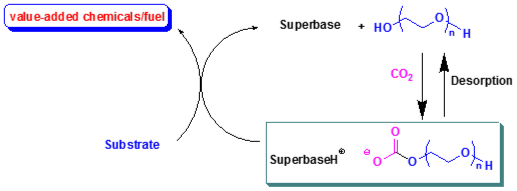
Abstract: A highly efficient binary system consisting of a polyethylene glycol and an amidine or guanidine superbase was developed for CO2 absorption, leading to activation of CO2 molecule; and thus direct conversion of the captured CO2 to value-added chemicals or fuels was successfully performed to avoid desorption process.
5. Zhen-Zhen Yang, Yu-Nong Li, Yang-Yang Wei and Liang-Nian He*, Protic onium salts-catalyzed synthesis of 5-aryl-2-oxazolidinones from aziridines and CO2 under mild conditions, Green Chem., 2011, 13, 2351-2353.[link]
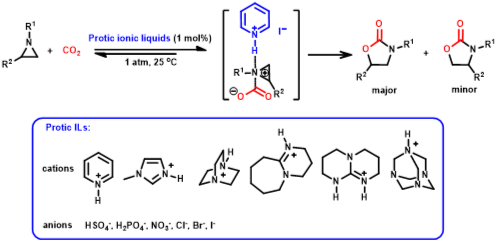
Abstract: Protic onium salts, e.g. pyridium iodide, proved to be highly efficient and recyclable catalysts for the selective synthesis of 5-aryl-2-oxazolidinones under a CO2 atmosphere at room temperature, presumably due to aziridine activation assisted by hydrogen bonding on the basis of 1H NMR and in situ FT IR under CO2 pressure study.
6. Zhen-Zhen Yang, Ya-Nan Zhao, Liang-Nian He*, CO2 chemistry: Task-specific ionic liquids for CO2 capture/activation and subsequent conversion, RSC Adv., 2011, 1 (4), 545-567 (invited by editor). [link]
>>> Top 10 cited review articles in RSC Adv (in 2012)
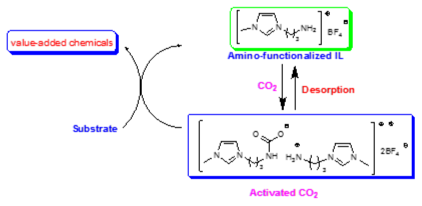
Abstract: Ionic liquids (ILs), a kind of novel green media composed entirely of cations and anions, have attracted considerable attention due to their unique properties such as non-volatility, tunable polarity, high stability and so on. In this article, the latest progress on the absorption and subsequent conversion of CO2 by using ILs as absorbents, catalysts or promoters will be summarized. The chemical absorption performance of ILs, especially task-specific ionic liquids (TSILs) such as amino-functionalized ILs, superbase-derived protic ILs has been systematically illustrated. Although significant advances have been made, extensive energy input in desorption process to recover absorbents would be still a crucial barrier to realize practical carbon capture and sequestration (CCS). On the other hand, efficient applications of CO2 in the synthesis of valuable compounds such as organic carbonates, urea derivatives, oxazolidinones and formic acid can also be promoted by employing TSILs as catalysts/reaction media. We anticipate that an integration of chemical capture of CO2 with its utilization, a so-called CO2 capture and utilization (CCU) protocol would be an ideal strategy to solve the energy penalty problem in common CCS without the need of heat desorption. The essence of this CCU concept is to use TSILs for CO2 capture and substantial activation, which could render catalytic transformation of CO2 to accomplish smoothly under low pressure (ideally at 1 atm).
7. Jing-Lun Wang, Cheng-Xia Miao, Xiao-Yong Dou, Jian Gao, Liang-Nian He*, Carbon Dioxide in Heterocyclic Synthesis, Curr. Org. Chem., 2011, 15(5), 621-646. (invited by editor) [link]
Abstract: As an abundant, nontoxic, nonflammable, easily available, and renewable carbon resource, carbon dioxide is very attractive as an environmentally friendly feedstock for making commodity chemicals, fuels, and materials. Owing to its kinetic and thermodynamic stability, significant efforts have been directed towards constructing C-C, C-O and C-N bond on the basis of CO2 activation through molecular catalysis. Development of catalytic methodologies for chemical transformation of CO2 into useful compounds is of paramount importance from a standpoint of C1 chemistry and green chemistry. The aim of this review is to demonstrate the versatile use of CO2 in heterocyclic synthesis, with the main focus on utilization of CO2 as a building block for synthesis of five- and six-membered heterocyclic compounds such as cyclic carbonates, oxazolidinones, imidazolidinones, lactones, quinazolines, etc. The potential use of dense CO2 as an alternative solvent and otherwise specific roles in the heterocyclic synthesis are also evaluated. We hope this presentation will stimulate further interest in research that may pave the way for selective synthesis of heterocycles employing CO2 as a synthon.
8. Jian Gao, Bing Yu, Liang-Nian He*, Reduction of Carbon Dioxide to Energy-Rich Products in Production and Purification of Ultraclean Transportation Fuels; Hu, Y. H., Ed.; ACS Symposium Series; American Chemical Society: Washington DC, 2011; Vol. 1088, pp 143-174.[link]
9. Zhen-Zhen Yang, Xiao-Yong Dou, Fang Wu, Liang-Nian He*, NaZSM-5-catalyzed dimethyl carbonate synthesis via the transesterification of ethylene carbonate with methanol, Can. J. Chem., 2011, 544-548.[link]

Abstract:NaZSM-5 zeolite was found to be an efficient heterogeneous catalyst for the synthesis of dimethyl carbonate (DMC), which can serve as a building block, an additive to fuel oil, and an electrolyte in batteries, via the transesterification of ethylene carbonate (EC) with methanol. Notably, 77% DMC yield and 97% selectivity were achieved under mild reaction conditions. Furthermore, the effects of various reaction parameters such as catalyst loading, reaction time, and methanol/EC molar ratio on the catalytic performance were investigated in detail. This protocol was found to be applicable to a variety of alcohols, producing the corresponding dialkyl carbonates with moderate yields and selectivities. Moreover, the catalyst can be recovered by simple filtration with retention of catalytic activity; a stable crystal configuration and a slight alteration of its superficial structure were observed by X-ray diffraction and BET measurements.
10. X-Y Dou, Q. Shuai, Liang-Nian He*, C.-J. Li*, Rhodium-catalyzed arylation of α-Amido Sulfones with Arylboronic Acids in Water-Toluene Biphasic Reaction System, Inorg. Chim. Acta, 2011, 369(1), 284-287.[link]

Abstract: An efficient method for the synthesis of N-protected diaryl-methyl-amines was developed through a rhodium-catalyzed arylation of α-amido sulfones with arylboronic acids in water-toluene biphasic system. Base combined with surfactant played a key role in this water-toluene biphasic reaction system. A diverse range of α-branched amines derivatives bearing different functional groups were obtained within 10 minutes under control conditions.
11. Yu-Nong Li, Jing-Lun Wang and Liang-Nian He*, Copper(II) chloride-catalyzed Glaser oxidative coupling reaction in polyethylene glycol, Tetrahedron Lett., 2011, 52 (27), 3485-3488.[link]

Abstract: Polyethylene glycol was shown to be an environmentally benign reaction medium for the copper(II) salt -catalyzed Glaser coupling reaction of terminal alkynes. In particular, oxygen as the sole oxidant worked very well for arylacetylenes even in short reaction time. The product was easily separated by extraction and the catalytic system could be reused four times without significant loss of reactivity.
12. De-Lin Kong, Liang-Nian He*, Jin-Quan Wang, Polyethylene Glycol-Enhanced Chemoselective Synthesis of Organic Carbamates from Amines, CO2 and Alkyl Halides, Synth. Commun., 2011, 41 (22), 3298-3307.[link]

Abstract: An efficient and environmentally benign method for the synthesis of organic carbamates was developed. Amines, CO2 and alkyl halides underwent a three-component reaction with the aid of K2CO3 and polyethylene glycol (PEG400, MW=400), affording the organic carbamates under ambient conditions. PEG could presumably act as a solvent, phase transfer catalyst (PTC). Notably, the presence of PEG could also depress the alkylation of both the amine and the carbamate, thus resulting in enhanced selectivity toward the target carbamate.
13. Sébastien Chanfreau, Bing Yu, Liang-Nian He* and Olivier Boutin, Electrochemical determination of ferrocene diffusion coefficient in [C6MIM][PF6]-CO2 biphasic system, J. Supercrit. Fluid., 2011, 56 (2), 130-136. [link]
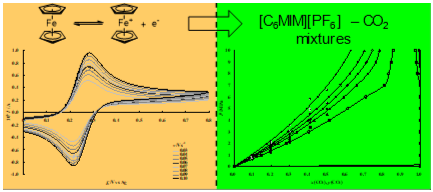
Abstract: Diffusion coefficient is an important property in chemical industry and precise measurements can be achieved by electrochemical techniques. Study of ferrocene diffusion was carried out in 1-hexyl-3-methyl imidazolium hexafluorophosphate-dense CO2 ([C6MIM][PF6-CO2]) biphasic system using microelectrode technique. Diffusion coefficients were determined by cyclic voltammetry and Randles–Ševčík relationship in the temperature and pressure ranging from 303.15-333.15 K and 1-10 MPa, respectively. Computed phase simulations were also used. Two-phase system was determined whatever experimental conditions and composition tested. Volumes of heavy and light phase were estimated as well. Both electroanalytical and computed studies showed that [C6MIM][PF6]-CO2 biphasic system containing initial molar fraction of CO2 up to 0.9 can be used without decrease in diffusion coefficient values. The order of magnitude of these diffusion coefficients of ferrocene in greener aprotic media are about 10−6 m2·s−1.
14. An-Hua Liu, Liang-Nian He,* Fang Hua, Zhen-Zhen Yang, Cheng-Bin Huang, Bing Yu and Bin Li, In situ Acidic Carbon Dioxide/Ethanol System for Selective Oxybromination of Aromatic Ethers Catalyzed by Copper Chloride, Adv. Synth. Catal., 2011, 353, 3187-3195. [link]
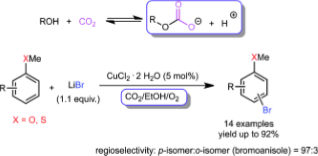
Abstract: An environmentally benign carbon dioxide/ethanol reversible acidic system was developed for the copper(II)-catalyzed regioselective oxybromination of aromatic ethers without the need of any conventional acid additive and organic solvent. Good to excellent yields together with very good regioselectivity were achieved when easily available cupric chloride dihydrate was used as catalyst and lithium bromide as the cheap and easy-to-handle bromine source under supercritical carbon dioxide conditions. Notably, the catalytic system worked well for a wide range of aromatic ethers including sulfides, resulting in the formation of the mono-brominated products in high yields and exclusive regioselectivity. The alkylcarbonic acid in situ formed from ethanol and carbon dioxide is assumed to play the crucial role in the Brønsted acid-promoted reaction, which could probably act as the proton donator, and was studied employing in situ FT-IR technique under carbon dioxide pressure by monitoring the vibration shift of the hydroxy group of ethanol. Given with excellent bromine atom efficiency as well as no need of neutralization in waste disposal, this approach thus represents a greener pathway for the aerobic bromination of aromatic ethers. A possible catalytic cycle for the in situ alkylcarbonic acid-assisted oxybomination and the effect of supercritical carbon dioxide, i.e., activation of alcohol and enhancement of mass transfer are also discussed.
15. S. Chanfreau, L.-N. He* and B. Yu, Electrochemical Behaviour of Ferrocene/Ferricinium Redox System in Pure and CO2 Saturated [C6MIM][PF6], ASEAN J. Chem. Eng., 2011, 11, 53-58.
16. Liang-Nian He, Xiao-Yong Dou, Yu-Song Gao, Feng Ye, Biomass-based energy: castor-derived biodegrabable lubricate and biodiesel from laboratory to pilot plant, Prep. Pap.-Am. Chem. Soc., Div. Fuel Chem. 2011, 56 (1), 15-16.
17. Liang-Nian He, Zhen-Zhen Yang, An-Hua Liu, Jian Gao, Carbon dioxide chemistry: ionic liquids-catalyzed transformation of CO2 into fuel additives and value addied chemicas, Prep. Pap.-Am. Chem. Soc., Div. Fuel Chem. 2011, 56 (1), 331-332.